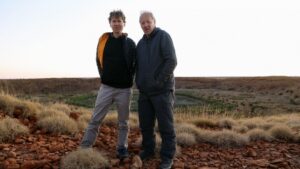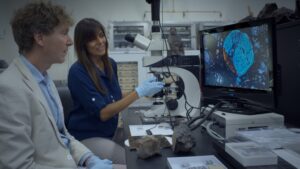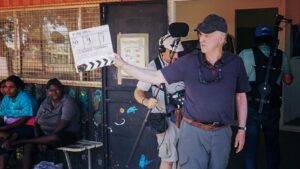
A meteor streaks across the Siberian sky, captured by startled drivers’ dashboard cameras. That eerie sight is one of many you will encounter in Fireball: Visitors from Darker Worlds, a movie that explores how meteorites have shaped life on our planet. It’s part of this season’s slate of Apple Original documentaries, now available on Apple TV+.
Fireball is the second collaboration between acclaimed director Werner Herzog and Clive Oppenheimer, a professor of volcanology at the University of Cambridge. Their previous film, Into the Inferno, received an Emmy nomination.
Oppenheimer sees Fireball as a natural progression from Into the Inferno. Speaking on a Zoom conference call with Herzog, he said the framework of the new documentary came to him when he joined South Korean scientists during their annual trip to Antarctica to hunt for meteorites. He wanted to combine expedition footage with a look into how shooting stars, stones that have fallen from the heavens, have affected cultures around the world.
“There was also a deeper guiding principle,” Herzog added. “Never be didactic. We do not touch any subject, any location, any person, without a deep sense of awe. There is not a single minute of shooting where there is not a deep excitement.”
Oppenheimer compiled a list of some thirty sites to cover, spanning the globe from religious shrines set within a meteor crater in Rajasthan, India, to Chicxulub Puerto, Mexico, site of the largest asteroid impact on earth. (Herzog describes a resort there as “so godforsaken you want to cry.”)

The meteor crash near the Yucatan Peninsula effectively reset the Earth’s biological clock, contributing to the extinction of dinosaurs and the eventual primacy of mammals. According to geochemist Nita Sahai, meteorites contain sugars and amino acids that are fundamental to life itself. Is it any wonder that ancient cultures regarded meteors with awe and terror?
Herzog praised his cinematographer Peter Zeitlinger. “He’s as strong as an ox. He was an ice hockey player in Prague during his adolescence,” he said. “The man knows what the collision of bodies means.”
“A lot of the people we’re filming have never had cameras stuck in their faces before,” Oppenheimer adds. “It can be intrusive, but there’s something about Peter’s personality, people accept how he moves around, how he gets very close. They aren’t overly distracted by him.”
Fireball includes breathtaking images of meteor dust and quasicrystals. Its landscapes are equally stunning, from the Wolfe Creek Crater in Western Australia to the Pan-STARRS Observatory at Haleakalā, Hawaii. The directors even obtained surreptitious footage of the sacred Kabba at Mecca, taken on a cellphone.
“Clive and I are not Muslims, so we cannot go to Mecca, they will not allow it,” Herzog said. “We had excellent archival researchers in London, from our coproduction company Spring Films.”
From the very start of the project, Oppenheimer was determined to visit Mer Island in the Torres Strait, an extremely difficult spot to reach.
“It’s a very small island, with a population of around 400,” he said. “It’s actually very important culturally for the recognition of indigenous land rights in Australia.”

According to Oppenheimer, in 1898 Cambridge zoologist Alfred Haddon visited the island to study marine invertebrates. He filmed the natives performing their tribal meteor dance, perhaps the first anthropological film. At the end of Fireball, Herzog and Oppenheimer film present-day natives performing the same dance.
“They believe departing souls are launched across the sky as fireballs,” Oppenheimer said. “The dance is beautiful, they have torches they beat together, and the sparks fly off into the atmosphere.”
Getting to Mer required transporting gear in a series of smaller and smaller aircraft, ditching lens cases to fit weight limitations, but getting off Antarctica proved even more difficult.
“The flight before we were due to leave dinged the ice runway,” Oppenheimer said, “so the runway was out of commission. We ended up getting stuck there for some time, to the point that we almost missed our next location.”
Herzog, who wrote and delivered Fireball‘s narration, is one of the world’s great raconteurs. He recalled bringing cinematographer Ed Lachman to Guadeloupe to film an erupting volcano for the 1977 short, La Soufrière.
“Edward, one of my wonderful collaborators, asked me, ‘Werner, what is going to happen if it blasts?’ ‘Edward,’ I answered, ‘we will be airborne.’ What else could I say?”
The director is also a font of advice about filmmaking.
“We didn’t go out and shoot this randomly,” he said. “We did the editing and narrowing down before we started. Very often you see filmmakers shooting everything, shooting everywhere, and then they sit on hundreds and hundreds of hours of footage.
“We were filming a Day of the Dead parade on the Yucatan Peninsula, shooting thousands and thousands of people with faces painted like skulls. I saw the cameraman shooting security people on the march and I said, ‘Turn it off, turn it off. You know why? We are filmmakers, we are not garbage collectors.'”





